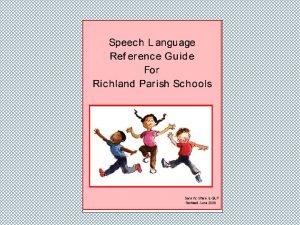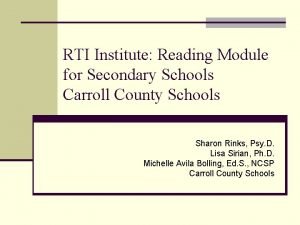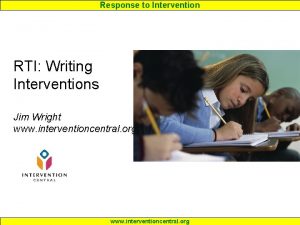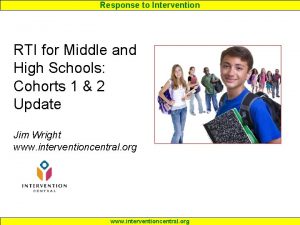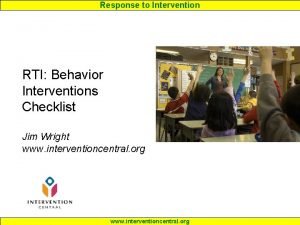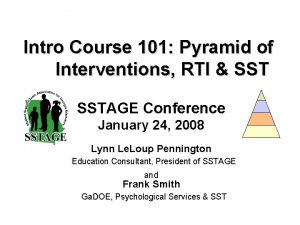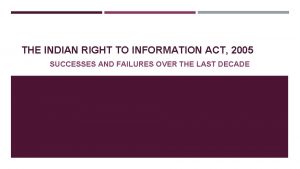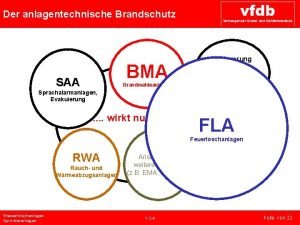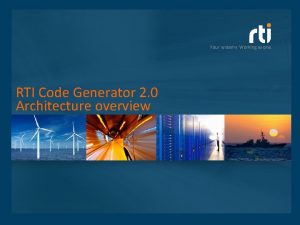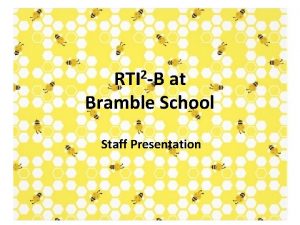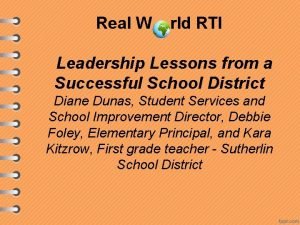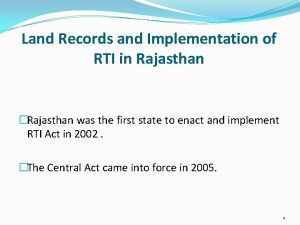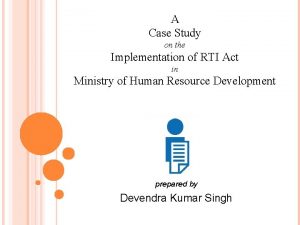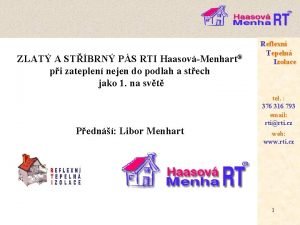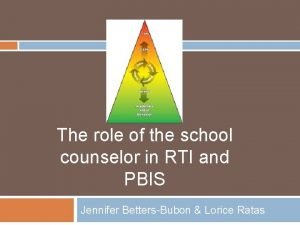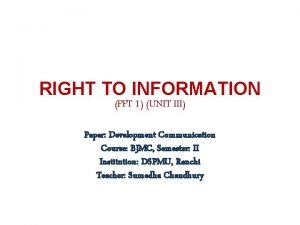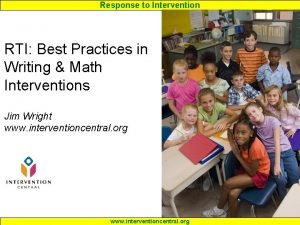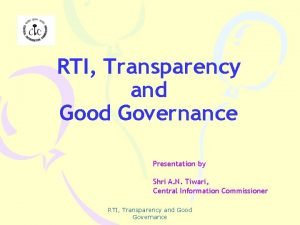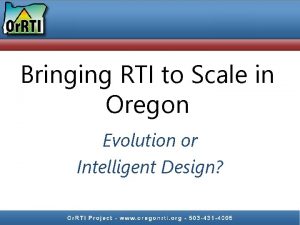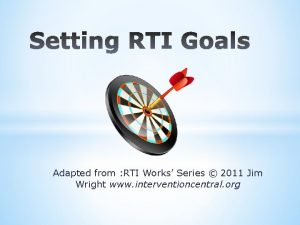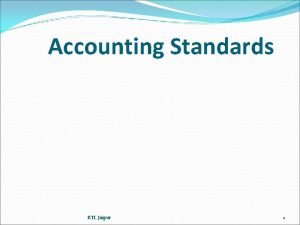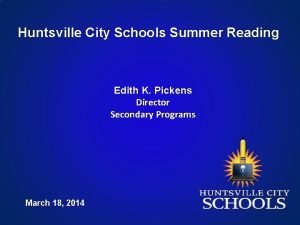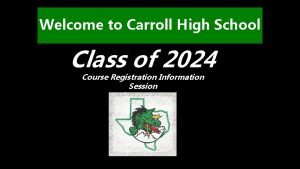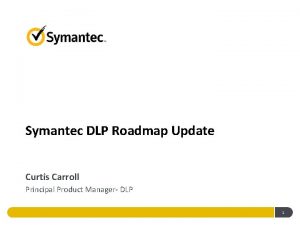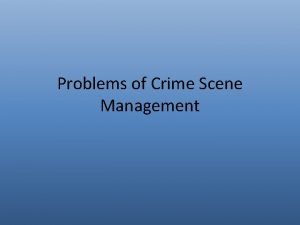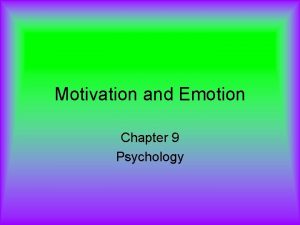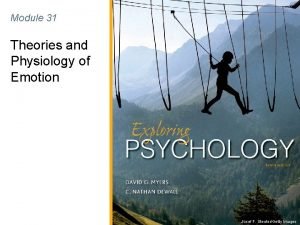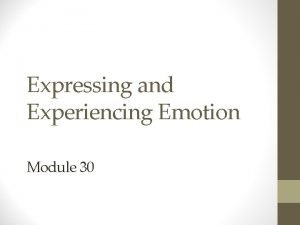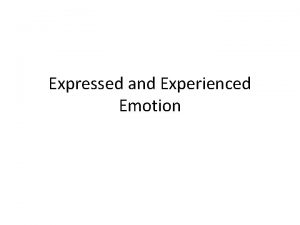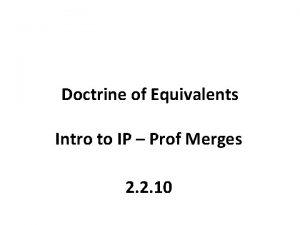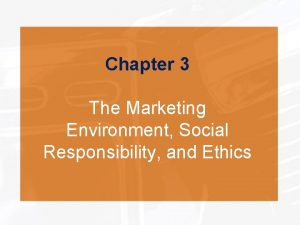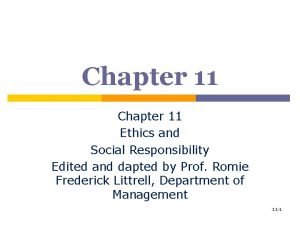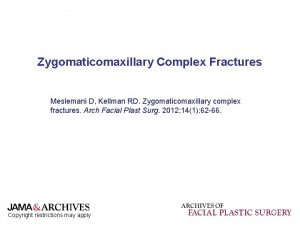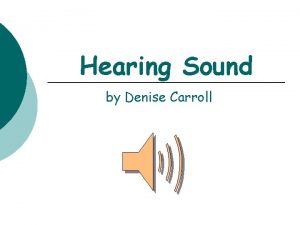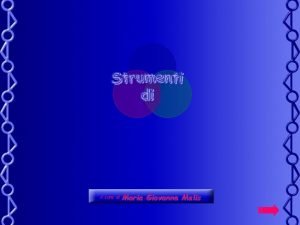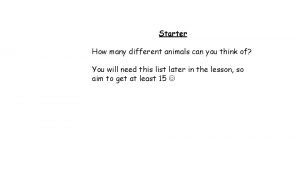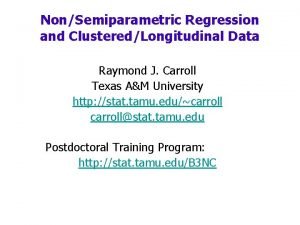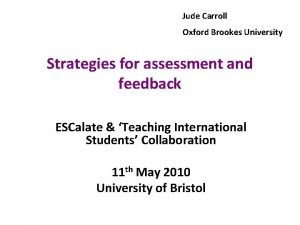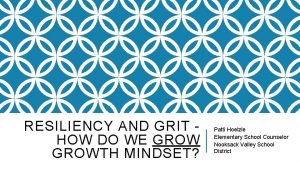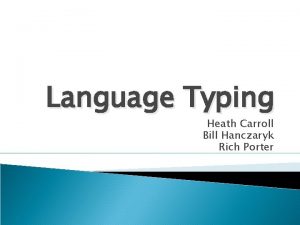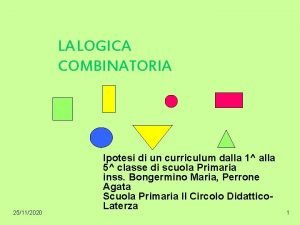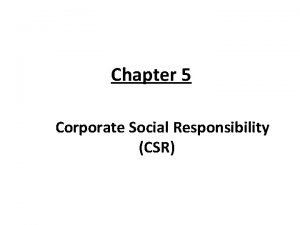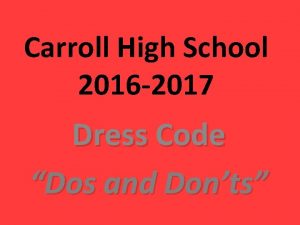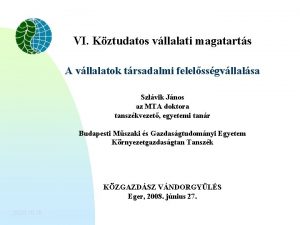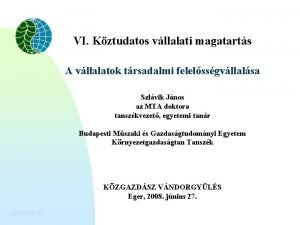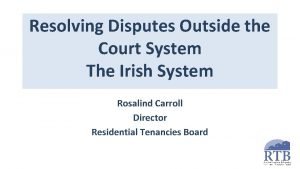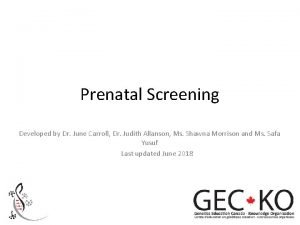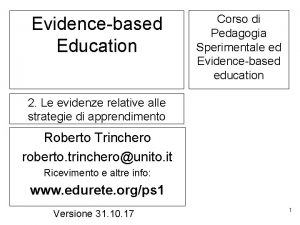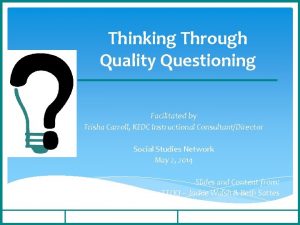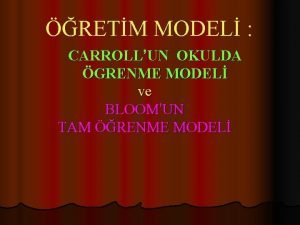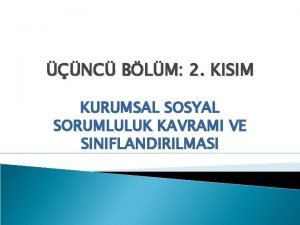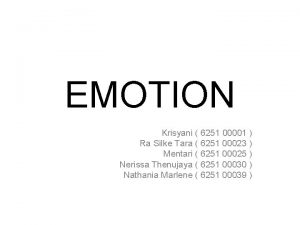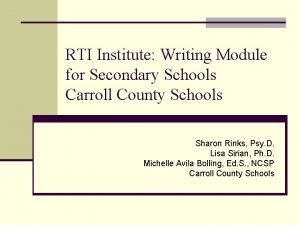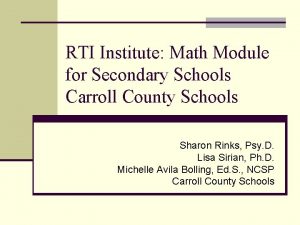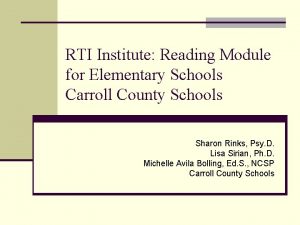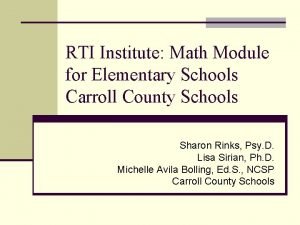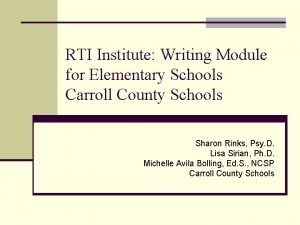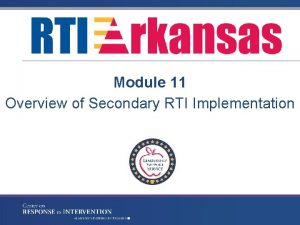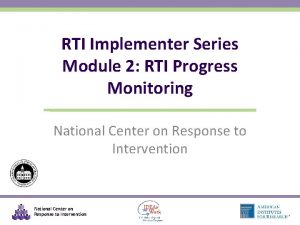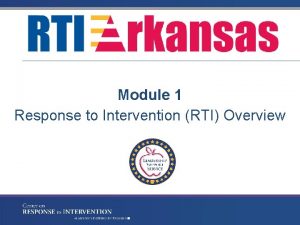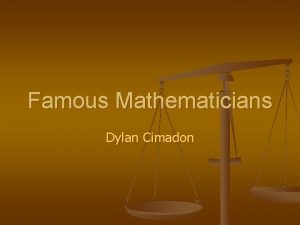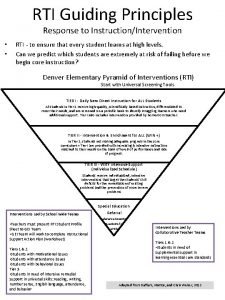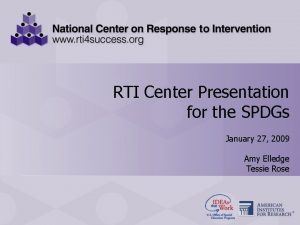RTI Institute Reading Module for Secondary Schools Carroll
























































































































































- Slides: 152

RTI Institute: Reading Module for Secondary Schools Carroll County Schools Sharon Rinks, Psy. D. Lisa Sirian, Ph. D. Michelle Avila Bolling, Ed. S. , NCSP Carroll County Schools

Team Contact Person & Subs Please make sure we get the email address of a contact person for each team. Write it on an index card and turn it in to a facilitator. ALSO, write down the number of team members that require a substitute.

Agenda n n Process the Application Activity Evidence-based RTI practices in reading BREAK (10 min) Practice progress monitoring administration n Progress monitoring & data entry n n Oral Reading Fluency Maze Practice data entry Review decision making for each case Case Studies Discuss Application Activity

Processing the Application Activity n How comfortable/confident do you feel about the level of consensus in your school? n What kinds of things did your group find out when you talked about core curriculum issues? n Does anyone feel really good about how their school assesses fidelity of the core curriculum? n What kinds of changes did completing this activity spur you to make at your school?

Exploring Evidence-Based Interventions for Reading

Research in Reading n 5% of children learn to read effortlessly n 20 -30% learn relatively easily once exposed to reading instruction n For 60% of children learning to read is a much more formidable task n For at least 20 -30% of children, reading is one of the most difficult tasks that they will have to master. n For 5% of students even with explicit and systematic instruction, reading will continue to be a challenge. Mac. Kenzie (2000), citing statistics from Lyon, Kamme’enui, Simmons, et al.

Research in Reading n Literacy levels are not declining– demands are simply getting higher (Torgesen, 2001) n Standards are higher in school n Literacy requirements are higher in employment settings n 38% of 4 th graders and 29% of 8 th graders cannot read well enough to effectively accomplish grade-level work (National Center for Educational Statistics, 2005) n These numbers are even higher for states with larger populations of low income students.

Research in Reading n Poor readers at the end of first grade almost never catch up by the end of Elementary School (Francis, Shaywitz, Stuebing, Shaywitz, & Fletcher; Juel, 1988, Torgesen and Burgess, 1998) n Verbal ability in children can be dramatically increased by effective reading instruction (Torgesen, Alexander, et. al. , 2001)

Prerequisite Beliefs Regarding Reading Instruction n The goal of reading instruction is for the child to acquire skills necessary to understand learn from the written text. n There are two general skills necessary to be a good reader Language comprehension n Accurate and fluent identification of words n

The National Reading Panel n Issued a report in 2000 n Responded to a mandate from Congress about concern over literacy skills in American schools n Reviewed over 100, 000 research studies on reading n Inspired an evidence-based approach to reading instruction n Summarized the following “BIG FIVE” critical skills for reading

Big Five #1: Phonemic Awareness n The ability to notice, think about and work with the individual sounds in spoken words. n n Phonemic awareness is not phonics Phonemic awareness is auditory and does not involve words in print n Phonemic awareness can be taught. n Training in phonemic awareness improves reading and spelling (NRP, 2000) n Approximately 20 hours of phonemic awareness instruction is sufficient for most early readers. (NRP, 2000)

Big Five #1: Phonemic Awareness n Phonemic Awareness is a subset of Phonological n n Awareness focusing on individual sounds It is the highest level of Phonological Awareness Essential to later recognition and comprehension of printed text (Torgesen & Mathes, 2000) Phonemic Awareness helps children learn to spell Phonological (NRP, 2000) Phonemic Phonological Awareness predicts reading skill better than IQ (Vellutino, Scanlon & Lyon, 2000)

Big Five #1: Phonemic Awareness n Examples of phoneme manipulation activities Alliteration n Isolation n Identification n Categorizing n Blending [/b/ /a/ /t/… what word is that? ] n Segmenting [what sounds are in the word bat? … /b/ /a/ /t/] n Adding, deleting, and substituting n Instruction that focuses on one or two phoneme manipulation activities (specifically blending and segmenting) rather than more, results in greater gains in reading and spelling. n

Big Five #2: Phonics n The relationship between the letters (graphemes) and the sounds (phonemes) in order to read and write words. n Differs from phonemic awareness Phonemic awareness focuses on the speech sounds in words n Phonics focuses on the letters and letter patterns used to represent those speech sounds n

Big Five #2: Phonics n The alphabetic principle n Denotes the systematic and predictable relationship between written letters and spoken sounds n Helps with word recognition and decoding n Phonics Instruction is most effective when it is: n Systematic- carefully selected set of lettersounds relationships organized in a logical sequence n Explicit- precise directions for the teaching of these relationships

Big Five #2: Phonics n Children who are delayed in phonemic awareness do n n not benefit as much from phonics instruction. Phonemic awareness establishes the context and structure for phonics. Phonics skills significantly contribute to reading comprehension. Phonics instruction is beneficial regardless of SES and most effective when introduced early. (NRP, 2000) Approximately 2 years of phonics instruction is sufficient for most readers. (NRP, 2000)

Big Five #3: Fluency n The ability to read a text accurately and quickly n To read expressively involves dividing the text into meaningful chunks. n Provides a bridge between word recognition and comprehension n Often been neglected n Fluent readers recognize words ad comprehend at the same time n Develops gradually over time and with practice

Big Five #3: Fluency n What causes dysfluent reading? n Low sight word vocabulary n Slow processing speed of known words n Low speed when decoding unfamiliar words n Using context to read words n Slow processing of word meanings (Moats, 2002)

Big Five #3: Fluency n One of the strongest findings in reading research is the positive relationship between fluency and comprehension. n Fluent reading frees up cognitive resources to dedicate to making sense of what you’ve read. n Measuring oral reading fluency can serve as a substitute for measuring overall reading proficiency. n One minute reading fluency probes are considered the best measures of overall reading ability. (Hall, 2006)

Big Five #4: Vocabulary n Knowledge of words we need to communicate effectively Oral vocabulary- words we use, recognize and understand in speaking and listening n Reading vocabulary- words we use, recognize and understand in print n n Most vocabulary is learned indirectly n Some MUST be taught directly

Big Five #4: Vocabulary n Language has been found to be a function of SES Lower SES students hear approximately 32 million fewer words by K than children of higher SES (professional) families. n There is a difference of 1500 fewer words/hour spoken in lower SES than professional families. n In lower SES families words are used for direction and punishment rather than discussion and sharing. n (Hart & Risley, 1995)

Big Five #4: Vocabulary n Lack of language is a difficult hurdle to overcome. n Children with low levels of language need to be in language enriched classes early on. n Vocabulary instruction should: Teach specific words n Teach students to learn words independently n Foster an appreciation and enjoyment of words n

Big Five #5: Comprehension n The reason for reading n The ultimate goal of reading instruction n Purposeful and active reading that occurs during passages rather than at the end n Instruction in comprehension strategies CAN improve reading comprehension n Involves making connections between prior knowledge and the current text

Big Five #5: Comprehension n Instruction should: n Be explicit & direct n n n Direct explanation Modeling Guided practice Application Tell students: n n (Armbruster, et al, 2001) When and why to use strategies What strategies to use How to apply them Use strategies flexibly and in combination

Big Five #5: Comprehension n Focus should be placed on comprehension right from the start, rather than waiting until the basics have been mastered n Four things influence comprehension Reader n Task n Text n Context n (RAND Reading Study Group, 2002)

Task Analysis READING Accurate and Fluent Word Identification Language Phonics Phonemic Awareness Fluency Vocabulary Reading Comprehension

Universal Screening in Reading n Tier 1 – all students screened for reading progress n Conducted 3 times per year n Early fall, midwinter & spring n Provides mechanism for identifying students at-risk for failure n Slightly over-identifies (false positives) n Allows schools to intervene early, before intensive intervention is necessary

Characteristics of Quality Screening Instruments n n n n Brief and easily administered Research-based Highly correlated to reading Predictive of future performance High reliability and validity Sensitive to small increments of change Alternate forms available Data analysis and reporting available

Case Study- Tier 1 In your teams, look at the school-level data for reading. What steps will your DAT take?

Research on Universal Screening n Use of multiple measures in a screening battery approach minimizes false positives (Jenkins & O’Connor, 2002) n At-risk and typically developing kindergarteners were differentiated better by using a screening battery approach (Letter Name Fluency, Phonemic Segmentation, and Syllable Elision) than by using any single universal screening measure (O’Connor & Jenkins, 1999)

Universal Screening in Reading n Not expected to assess ALL of the BIG Five. n Reading comprehension is a mixture of complex abilities; however, research helps provide us a direction for universal screening. n Oral Reading Fluency (ORF) n n n Assesses a child's skill in reading connected text of grade-level material using one-minute fluency probes The most researched, efficient and standardized measure of reading proficiency Measuring oral reading fluency can serve as a substitute for measuring overall reading proficiency, especially in the lower grades.

Universal Screening in Middle Grades n At the middle grades: n ORF typically plateaus around 150 words correct per minute (Torgesen et al. , 2007) n Predictive value declines n Utility for progress monitoring diminishes (Yovanoff, Duesbery, Alonzo, and Tindal, 2005) n It is important to identify which students have not reached the plateau; in this case, ORF is still an appropriate measure to use. n Benchmark assessments may be used to identify the lowest performing 20%

Universal Screening in Upper Grades n Logistically difficult at the middle and high school level n Little research is available; as a result, we have the opportunity to develop our own practices that we believe are most aligned with the spirit of RTI n There is some evidence that the following are appropriate at the high school level: n Vocabulary fluency probes n Vocabulary matching probes n Oral retell measures n Maze passages n Benchmark Assessments (Howell, 2008) n It is still important to identify which students have not reached the 150 wcm plateau; in this case, ORF is still an appropriate measure to use.

Available Universal Screeners n DIBELS n n Free to download at www. dibels. uoregon. edu For grades K-6 Has a Spanish version (IDEL) Measures n n n n n ISF: Initial Sounds Fluency LNF: Letter Naming Fluency PSF: Phoneme Segmentation Fluency NWF: Nonsense Word Fluency ORF: Oral Reading Fluency RTF: Retell Fluency WUF: Word Use Fluency May over identify false positives District data analysis indicates that it is strongly predictive of performance on the CRCT.

Available Universal Screeners n Curriculum Based Measurement - Free n Letter-Name Fluency n Letter-Sound Fluency n Initial-Sound Fluency n Phoneme Segmentation Fluency n Nonword Reading Fluency n Oral Retell Fluency n Maze Fluency n Vocabulary Probes n Some CBM probe generators are available at http: //www. interventioncentral. org/htmdocs/interventi ons/cbmwarehouse. php

Available Universal Screeners n Scholastic Reading Inventory n Grades 1 -12 (should be used only if students are already reading) Cost- $2950/200 students + $299/additional 50 Get a 50% discount if you switch from STAR reading May be beneficial especially for older grades (7 -12) n http: //teacher. scholastic. com/products/sri/ n n 4 Sight- Reading / Success for All n Grades 3 -11 n http: //successforall. com/elementary/4 sight. htm n Aimsweb n n n Uses CBM in: ORF, Maze, Early Literacy, Spelling, Early Numeracy, Written Expression, and Math www. aimsweb. com Grades K-8 for universal screening $3/student for just reading $5/student complete (reading, language arts and math computation)

Available Universal Screeners n GKAP/GKIDS n For Kindergarten n GRADE- Group Reading Assessment and Diagnostic Evaluation n Ages 4 -25 Cost- $210 -$329/ set depending on grade level Complete pricing information http: //www. sedl. org/cgibin/mysql/rad. cgi? searchid=217 n STEEP- System to Enhance Educational Performance K-12 Materials for purchase n http: //www. isteep. com/index. html n

Considerations in Selection n What goals do you have for universal screening for next year? Three years from now? n What type of information do you hope to collect about student progress in reading? n What approach will you use? n What resources are available? n n Time Money Personnel Technology n How will teachers be trained and provided with ongoing support?

Team Activity Discuss your current procedures for universal screening in reading. What changes do you need to make? What are your first steps?

Interventions n Five areas n Phonemic Awareness n Phonics n Vocabulary n Fluency n Comprehension

Interactive Table of Contents

Phonemic Awareness Interventions

Phonemic Awareness Interventions n Sound Boxes n Sound Sorts n Kinesthetic Activities n All Aboard! n Blending Sounds Activities n Segmenting Sounds Activities n Oops Wrong Rhyme n Phonemic Activities for Reading Readiness n Phoneme Identification with the ABC Chart n Rhyming Picture Sort

Kinesthetic Activities to Increase Phonological Awareness n Sound Detectives - Can be done at the word, syllable or phoneme level - Students are given a word, specific syllable (e. g. , prefix or suffix), or sound to listen for - Teacher reads a sentence and the students count the number of times they heard the target sound/word - Any manipulative may be used for them to keep track or they can use the Sound Detectives work sheet - On this sheet the children use a pencil to connect the dots each time they hear the target

Phonics Interventions

Phonics Interventions n n n n n Fill in the Sound Beginning Sounds Beach Ball Practicing Word Families Letter-Sound Association Cards Making Words Touch and Say Syllable Puzzles Word Chains Flexing Syllables for Multisyllabic Words

Flexing Syllables for Multisyllabic Words Example of the activity: n First the teacher writes document on the board n Then the teacher asks, “how may vowels are there in the word? ” n Student “ 3!” n Teacher “Are they together or apart? ” n Student “Apart!” n Teacher “Do you see a silent e? ” n Student “No” n Teacher “Okay, good job. How many syllables are there in the word? ” n Student “ 3!” n Teacher “Okay, now please write them on the syllable boards. ” n The student then writes each syllable on a different syllable board n n (whiteboard cut into 3”x 5” pieces): Do cu ment Student pronounces the word If the pronunciation doesn’t sound right, teacher helps to “flex” the syllable This is done by erasing the c from the second syllable board and writing the c on the first syllable board. This time the syllable boards will look like this: Doc u ment Ask the student to read the word again – this time it should sound correct

Vocabulary Interventions

Vocabulary Interventions n n n n n Semantic Word Webs Word Meaning Sorts 5 Steps for Building Vocabulary Flash Card Practice n Traditional Drill and Practice n The Spiral Notebook n Front and Back Flashcards n Photo Flashcards n The Recipe Word Box Scaling Antonym Pairs Vocabulary Map Semantic Feature Analysis Human Word Web If it Fits SWGC

Address the Vocabulary (Tilton, 2003) n 4 th – 12 th graders n Use an address book to create a “mini dictionary” n Student writes the word and definition in the address book under the appropriate letter n Can be used throughout the school year, whenever needed

Spiral Notebook n 4 th – 12 th graders n A vocabulary-building activity that can be engaged in n n throughout the year, whenever there are new vocabulary words A 3” x 5” spiral note card book is cut vertically down the center Vocabulary words are listed on the stack to the left Their definitions are listed on the stack to the right The student can review the words and, if he can’t remember the definition, he can consult the stack on the right

Selecting Interventions n Oral Reading Fluency and Maze Fluency n Very low scores suggest a need to focus intervention on decoding and word identification n Somewhat low scores suggest a need to focus on fluency n Average scores suggest that ongoing vocabulary instruction and text comprehension strategies are appropriate n Looking for fluency rate of 150 wcm on grade level text

Fluency Interventions

Fluency Interventions n n n n Assisted Reading Practice Error Correction Kids as Reading Helpers Listening, Practice, Preview Paired Reading Repeated Reading Choral Reading Duet Reading Repeated Oral Readings Radio Reading Word Study/ Speed Sorting Poetry Coffee House Flash Card Drill & Practice Memorizing Nonphonetic Heart Words

Memorizing Nonphonetic “Heart Words” n Can be use to help readers memorize non-phonetically spelled n n n words or “sight words” Teacher assists the children with identifying the pieces of words that must be memorized “by heart” Word cards or white boards with markers can be used Variation: cut hearts out of red cellophane A think aloud dialogue should be used with each word to identify which parts of the word follow normal patterns and which parts require memorization – to know them “by heart” Example: The word “friend” f r ie n d The ‘ie’ in friend must be memorized, or learned by heart.

Choral Reading (Rasinski, 2003) Three or more participants of any age Provide each student appropriate text Have students read text independently first Then read all together, pointing to the word as it is spoken, reading known words aloud n Hearing others read aloud at the same time helps “fill in the blanks” n Variations: alternate slow and fast, loud and soft lines, emphasize key lines, clap at end of lines, etc. n n

Choral Reading Checklist (Rasinski, 2003) Did you. . . (circle your answer) 1) read aloud all the words that you knew how to pronounce? YES NO 2) try to say words you did not know when you heard others? YES NO 3) speak loudly enough to be heard, but not too loudly? YES NO 4) use an expressive voice? YES NO 5) pause at the punctuation? YES NO 6) follow the pace set by the instructor or model student? YES NO 7) point at the words as they were being spoken? YES NO 8) make an effort to improve your performance? YES NO

Poetry Coffeehouse n Teacher reads a poem, short story, or another piece of n n n work aloud to students at the beginning of the week Throughout the rest of the week, students practice this and other works of their choosing aloud and silently, getting feedback as needed from the adult and/or peers On Friday, the “stage” is set and the lights are lowered to give the room an authentic coffeehouse feeling Students “perform” their pieces individually, in pairs or trios, and/or in large groups After performing, each student completes a Poetry Coffeehouse Student Self-Assessment form If the performance was recorded, the student may wish to view the recording before completing the selfassessment

Poetry Coffeehouse Student Self. Assessment

Repeated Reading (Rasinski, 2003) n n n For any age Requires a student to read aloud a selection that is at or near the student’s current instructional reading level until criterion reading rate achieved Reading passage should be 50 – 500 words, at or near student’s instructional reading level Once student has achieved target criterion level, assign a new passage that is as difficult as or slightly more difficult than the passage just mastered Use Repeated Reading Log to keep track of the passages the student is working on daily and the dates they are mastered

Repeated Reading Log (Rasinski, 2003)

How to Determine the Difficulty Level of a Passage Adapted Fry Method: Determine the average number of syllables per sentence in the target passage. n n n Count the number of syllables in the words in the first 10 sentences. Divide the total number of syllables by 10 (or just move the decimal point one place to the left). Compare your figure against the chart below. Grade Level 1 2 3 4 5 6 7 8 9 10 11 12 Syllables per Sentence less than 8. 4 8. 5 -11. 8 11. 9 -14. 5 14. 6 -16. 3 16. 4 -18. 1 18. 2 -2. 9 22. 0 -26. 7 26. 8 -29. 4 29. 5 -33. 6 33. 7 -37. 4 37. 5 -37. 8 37. 9 -39. 3

Comprehension Interventions

Comprehension Interventions n Keywords: A Memorization Strategy n Main Idea Maps n Mental Imagery: Improving Text Recall n Oral Recitation Lessons n Prior Knowledge: Activating the Known n Question Generation n Reciprocal Teaching n Text Lookback n Question Generation/Question Answering n Response Cards n PQ 4 R

Comprehension Interventions n n n n PQ 4 R Advanced Story Maps Question-Answer-Relationship (QAR) Green, Yellow and Red Question Cards 5 W’s and 1 H Click and Clunk Self-Monitoring Reading Comprehension Graphic Organizers for Comprehension n n Cornell Note Making KWL n RAP-Q n RUD-PC

Reading Comprehension through Self. Monitoring n Reading Comprehension can be increased through the use of self-monitoring techniques. n Students can be taught to self-monitor using both direct and indirect, and quantitative and qualitative methods. n Direct methods measure the work a student is producing, while indirect methods include selfassessment of skills. n Direct Quantitative Methods n n n Frequency Chart Text Look-Back Duration Chart

Duration Tracker (Joseph, 2006) Passage 1 Passage 2 Passage 3 Passage 4 Passage 5 Passage 6

Reading Comprehension through Self. Monitoring n Direct Qualitative Method n Narration n Indirect Quantitative Method n Self-Perception

K-W-L Integrates effective comprehension strategies before, during, and after reading Distribute copies of the K-W-L graphic organizer and tell students to record information as they read and write their responses on the board To complete the K (Know) column, lead the class to share their background knowledge about the subject of the reading passage; reinforce the importance of background knowledge in clarifying and remembering new information To complete the W (Want To Know) column, lead the class to generate questions they have about the topic; review the importance of asking questions prior to reading and the benefit of having a purpose for reading Provide time for students to read the passage To complete the L (Learned) column, allow students to share important concepts from their reading; lead the class to note any factual inaccuracies from the K column and supply any significant information that is missing after students respond Lead students to determine if all of their questions have been answered n n n n n If not, discuss where to look for this information The class may also want to generate additional questions that arose from their reading

RUD-PC Developed to teach students to read from the computer screen Students will Read the title and headings of the web page n n Students will Use the cursor to skim the page – browse through some but not all of the information on the page quickly in an effort to find out what the website is about Students will Decide if the page is worth their time and effort to read it more carefully n n n Ask students to pay attention to how the page is organized – e. g. , boxes or circles with information vs. book form Direct students to pay special attention to the larger boxes that typically contain more information If they need the information, they will be instructed to read the page carefully Students should use a system to read all of the boxes on the page (e. g. , larger boxes then smaller boxes, or left side then right) Students will Print the page if they want to read the identified information in more detail or bookmark the page to read it later Students will Collect information necessary to create a bibliography by copying the URL or the website address and locating the author, title, and publication date

Question Generation/Question Answering n Targets the student’s ability to answer questions after reading n n n text Ask students to create “think-type” questions while reading to increase their cognitive involvement, focus attention on important concepts, encourage the reader to reach beyond the written text, and facilitate active engagement with the text “Think-type” questions differ from “locate questions” in that the answer cannot directly be found by re-reading the passage Model the strategy using a think aloud and self-reinforcement (positive self-talk) Teach the procedure until students can use it independently; reinforce daily To help children learn the strategy, n n n Let them refer to an index card with the steps on it Use a structured Self-Monitoring strategy checklist Use a graphic organizer to structure the task for students and use it as a study guide for tests

Green, Yellow & Red Question Cards n Asking students to answer a series of questions before, during and after reading increases their cognitive involvement, focuses attention on important concepts and facilitates active engagement with the text. GREEN- Pre-Reading What does the title tell me about the story? What do the pictures tell me? What do I already know about …? (the topic) YELLOW- During Reading Who is this about? What’s going on? (state the problem) When is this happening? Where is this happening? Why did … happen? (describe why something happened) How was the problem solved? What will happen next? (predict) RED- After Reading Tell about the characters. Tell about the setting. What was the problem? How was the problem solved?

Click or Clunk? (www. interventioncentral. com) n Provide students with something to read n Instruct students that when they come to: n The end of a sentence, they should ask themselves, “Did I understand this sentence? ” n If they did understand, they say “Click!” and keep reading n If they did not understand, they say “Clunk!” and refer to Reading Check Sheet n The end of a paragraph, they should ask themselves, “What did the paragraph say? ” n The end of each page, they should ask themselves, “What do I remember? ”

Click or Clunk: Reading Check Sheet (www. interventioncentral. com)

Keywords: A Memorization Strategy

Progress Monitoring Reading

Progress Monitoring (PM) in Reading n Frequent teacher assessment of student performance n n n using brief measures Catches potential false positives from universal screening Is not meant to be diagnostic Tier 2 – conduct PM every 2 -3 weeks Tier 3 - conduct PM every 1 -2 weeks Tier 4 - conduct PM of IEP Goals n Goals and schedule established by IEP committee n Assist in establishing instructional goals n Help make intervention decisions

Progress Monitoring (PM) in Reading n Meant to be n Fast n Inexpensive n School-friendly n Provides continuous measurement of performance n Measures rate of growth n Can often be accomplished using alternate forms of your universal screener n With adequate training, may be administered by pararprofessionals

Advantages n PM versus norm referenced data n Based on district curriculum n Students are compared against their own progress versus state or national norms n Compared against students own grade level peers n Continuous measure of direct performance n Highly sensitive to growth or lack thereof n Teacher and parent friendly

Guidelines for PM n All the probes are different, but should assess the same skills at the same grade level n PM data must be graphed to easily make decisions n Ambitious goals lead to greater improvement

Progress Monitoring Measures n DIBELS (free) n AIMSWEB n CBM (free) n Edcheckup n Monitoring Basic Skills n STAR n CTB/Mc. Graw-Hill Yearly Progress Pro

● Met criteria ○ Did not meet

Important Notes on ORF n Even though ORF is frequently used to monitor progress: n n Kids reading faster is not the ultimate goal of reading instruction. We use it to gauge if kids are becoming better readers n ORF is an overall indicator of reading competence n Students who have higher ORF rates n Are better decoders n Are better at sight vocabulary n Are better comprehenders n ORF correlates highly with high stakes tests

Useful Websites for PM Info n National Center on Student Progress Monitoring www. studentprogress. org n Research Institute on Progress Monitoring www. progressmonitoring. org n Curriculum Based Measurement Warehouse http: //www. interventioncentral. org/htmdocs/int erventions/cbmwarehouse. php

DIBELS (Dynamic Indicators of Basic Early Literacy Skills) n Standardized, individually administered measures of n n n early literacy development Short (one minute) measures Based on the National Reading Panel (2000) and National Research Council (1998) reports Assesses phonological awareness, alphabetic understanding, automaticity and fluency Reliable and valid Predictive of later reading proficiency Provides comprehensive data management and reports for district, school, grade, class, and individual student level (costs $1/student)

Oral Reading Fluency n This is what the examiner booklet looks like n The student sees the passage copied on an 8 ½ by 11 sheet of paper.

CBM n Scientifically validated n Based on 30 years of research n Sources of CBM Materials n The ABCs of CBM: A Practical Guide to Curriculum. Based Measurement (Guilford Publishing) n AIMSweb/Edformation n DIBELS n Edcheckup n Mc. Graw-Hill n Pro-Ed, Inc. n Vanderbilt University

CBM Probes Letter-Name Fluency n Letter-Sound Fluency n Initial-Sound Fluency n Phoneme Segmentation Fluency n Nonword Reading Fluency n Oral Retell Fluency n Maze Fluency n Vocabulary Probes n

CBM Maze Fluency Probes n Given a grade level passage from which every 7 th word has been deleted, the student selects a word from three choices provided. n Scoring requires counting the number of words replaced correctly in 2. 5 minutes n May be group or individually administered

CBM Maze Probes Place the silent reading passage in front of each student and say: “When I say ‘begin’ I want you to read a story. You will have 2. 5 minutes to read the story. Some of the words in the story are replaced with a line that has 3 words under it. Your job is to circle the one (1) word that makes the most sense in the story. Only one (1) word is correct. ” “When I say ‘begin’ turn to the first story and start reading silently. When you come to a group of three words, circle the one (1) word that makes the most sense. Work as quickly as you can without making mistakes…”

Vocabulary Matching Probes n Sample broad vocabulary domains n Typically 60 words with definitions n 20 words and definitions per page on 3 pages n Five minutes per probe n May use academic vocabulary or topic specific/technical vocabulary n May establish local benchmarks by randomly administering to a sample of successful students (Espin et al, 2005)

Vocabulary Matching 1. A small green insect 2. Small drops of water 3. Delightful, fascinating 4. An animal like a 5. 6. 7. 8. small horse with big ears To have, to own Make a short, sharp sound A song, a tune Strongly attracted a. Chirp b. Enchanted c. Charming d. Melody e. Dew Donkey g. Grasshopper h. Possess f.

Possible cut-off scores for CBM Grade CBM Probe Cut-off Kindergarten Letter Sound Fluency < 10 letters/minute Grade 1 Word Identification Fluency < 15 words on list/minute Grade 2 Passage Reading Fluency < 15 words in text/minute Grade 3 Passage Reading Fluency < 50 words in text/minute Grade 4 Maze Fluency < 10 Maze replacements/ 2. 5 minutes Grade 5 Maze Fluency < 15 Maze replacements/ 2. 5 minutes Grade 6 Maze Fluency < 20 Maze replacements/ 2. 5 minutes (Mellard, 2008)

Goals for Academic Growth (ORF) Grade Realistic Ambitious 1 st 2 words/week 3 words/week 2 nd 1. 5 words/week 2 words/week 3 rd 1 word/week 1. 5 words/week 4 th 0. 85 words/week 1. 1 words/week 5 th 0. 5 words/week 0. 8 words/week 6 th 0. 3 words/week 0. 65 words/week (Fuchs & Fuchs, 1993)

Goals for Academic Growth (Maze) Grade Rate of Improvement 1 st 0. 4 maze replacements/week 2 nd 0. 4 maze replacements/week 3 rd 0. 4 maze replacements/week 4 th 0. 4 maze replacements/week 5 th 0. 4 maze replacements/week 6 th 0. 4 maze replacements/week

CBM End of Year Goals n n n n K: 40 correct letter sounds per min (LSF) 1: 60 words correct from list per min (WIF) 1: 50 words correct from text per min (ORF) 2: 75 words correct from text per min (ORF) 3: 100 words correct from text per min (ORF) 4: 20 replacements to text per 2. 5 min (MAZE) 5: 25 replacements to text per 2. 5 min (MAZE) 6: 30 replacements to text per 2. 5 min (MAZE) LSF= Letter Sound Fluency, WIF= Word Identification Fluency, ORF= Oral Reading Fluency, MAZE= Maze Fluency

Middle Grades ORF Benchmarks

Case Study- Tier 2 In your groups look at the grade-level data provided for reading.

Progress Monitoring & Graphing Data Please turn on your laptop.

Research on Progress Monitoring n In making decisions about instruction, the use progress monitoring results in: Increased student achievement n Better decision-making n Greater student awareness of their progress n (Fuchs, Deno, Mirkin, 1984; Fuchs, Hamlett, & Ferguson, 1992; Stecker, Fuchs, & Fuchs, 2005)

Progress Monitoring Your Intervention Plan n You have to monitor your plan to make sure that it is having the desired results. n This helps you make decisions about your plan. n The Excel data tool on your CD will allow you to graph progress. n Ideally, the majority of the progress monitoring data will be collected and entered by the student’s teacher(s).

Progress Monitoring in an RTI Framework

Progress Monitoring in an RTI Framework Step 1: In the Progress Monitoring Folder, open “Progress Monitoring_MB. xls”

Progress Monitoring in an RTI Framework Important Points to Highlight

Progress Monitoring in an RTI Framework Enter correct intervention Tier

Progress Monitoring in an RTI Framework Enter student information.

Progress Monitoring in an RTI Framework Specify the intervention.

Progress Monitoring in an RTI Framework Establish the goal.

Writing Goals for Progress Monitoring n Set the target for outcome n Realistic, yet challenging n The minimum expected performance n Example for 6 th grade student: n n reading 52 wcm at baseline (August) GOAL to read 120 wcm by Midwinter (December) n Do NOT wait until the next Universal Screening or Benchmark Assessment n Prorate your goal by doing a little math.

Writing Goals for Progress Monitoring n Subtract the baseline rate (52) from the goal (120) and divide by # of weeks until benchmark assessment to get ROI. 120 -52= 68 wcm 17 wks until midwinter assessment n n Rate of Improvement (ROI)= 4 wcm/wk n ROI x number of intervention weeks (6) = 24 n GOAL = 52 (baseline) + 24 = 76 wcm

Writing Goals for Progress Monitoring n A possible format n In (time frame), (student) will (describe what they will do) on (name the progress monitoring measure), to achieve (desired performance level). n Example n In six weeks, Michelle will read second grade text on DIBELS Oral Reading Fluency probes, to achieve a rate of 76 words correct per minute.

Don’t Worry… n We will show you might go about establishing and writing goals for the other areas: Writing n Math n And Behavior n in our future modules.

Progress Monitoring in an RTI Framework Write your goal in the “Goal” box.

Progress Monitoring in an RTI Framework Specify your intervention.

Progress Monitoring in an RTI Framework Enter end date and outcome goal.

Progress Monitoring in an RTI Framework Note the goal line has moved.

Progress Monitoring in an RTI Framework Enter your baseline data.

Progress Monitoring in an RTI Framework Data points automatically graph.

Progress Monitoring in an RTI Framework Notice the aim line in red.

Progress Monitoring in an RTI Framework Intervention is definitely needed.

Progress Monitoring in an RTI Framework Begin your intervention.

Progress Monitoring in an RTI Framework Enter progress monitoring data.

Progress Monitoring in an RTI Framework Enter progress monitoring data.

Progress Monitoring in an RTI Framework Continuously evaluate progress.

Progress Monitoring in an RTI Framework Make a data-based decision.

Data-Based Decision Making n When the trend line is above the aim line, adequate progress is being made n When the trend line is below the aim line (or flat), instructional changes are necessary n Other rules of thumb 3 -4 consecutive data pts below the aim line may indicate a need for change n If 6 consecutive data points are above the aim line, the goal is likely too low and should be increased. n

Progress Monitoring in an RTI Framework Enter committee decision.

Progress Monitoring in an RTI Framework What if it looked like this?

Progress Monitoring in an RTI Framework Note the different decision.

Team Work Take a moment to enter the data from your progress monitoring case study. Let all team members participate so you all are comfortable with the graphing tool. Discuss the data and make a decision about your intervention.

Example #1 - Annaliese

Example #2 - Jason

Example #3 - Barry

Example #4 - April

Example #5 - Ruth

There are other ways to graph data. DIBELS Intervention Central Paper & Pencil



n You can make graphs just like the DIBELS ones by hand. Just make sure you have the essential data on it. n You can also go to http: //www. jimwrightonline. com/php/chartdog _2_0/chartdog. php#obsv 0 to make a chart for progress monitoring just about anything.

Chart Dog graphs will look like this. The trouble is there is no goal or aim line, so you’ll have to draw these on it.

I’ve added them. Is the child making adequate progress?

You don’t need anything fancy. n Graph paper and a pencil will do. n Remember to include: n Y axis (what you are measuring) n X axis (dates of data points) n Baseline (where the student started – before you began intervention) n Goal (where the child needs to be) n Aim line (connects baseline to goal) n Data points (one every 2 weeks)

Progress Monitoring n Data points should be collected not less than every 2 -3 weeks for students who are having difficulty. n Every 1 -2 weeks is best for students who are having a lot of difficulty. n Students who are at benchmark do not need frequent progress monitoring. (1 x/mo if cautious or even the 3 x/year benchmarks are fine)

Important Points n Progress monitoring is used to see if interventions are working. n You must be able to n n Identify the intervention period n Date began: _____ Date ended: ____ Identify the evidence-based intervention n ___________ Identify the schedule of the intervention n ______minutes, _______ times per week Identify the intensity of the intervention n # ____students: __ teacher/parapro

Break!

Team Work Case Studies

School-Level Data Analysis

Class-Level Data-Analysis Based on this data • How well does your core address reading? • Look at this teacher what can we learn here? • What classes need help? • How can you help them?

Class-Level Student Data This is a 6 th grade class. 20% of students were below basic at midwinter assessment (lexile range BR-499)

Sample Tier 2 Intervention Form

Application Activity n Select a student with a reading concern n Collect baseline data using an appropriate progress n n n n monitoring tool Establish a goal Enter the data into the Excel graphing tool Determine the intervention strategy and the schedule of implementation Determine who will do it Establish a method and schedule for progress monitoring Document on the appropriate Tier Intervention Form Begin the intervention

Resources n To generate progress monitoring reading probes visit OKAPI n http: //www. interventioncentral. org/htmdocs/too ls/okapi. php n To generate progress monitoring reading probes for letter identification and word list/Dolch idenitification probes visit n http: //www. interventioncentral. org/htmdocs/too ls/cbaprobe/cba. php
 While reading activities
While reading activities Powerschool huntsville city schools login
Powerschool huntsville city schools login Safety target reach schools
Safety target reach schools Level of education in malaysia
Level of education in malaysia Objectives of teaching economics at secondary level
Objectives of teaching economics at secondary level Serp.doe.louisiana
Serp.doe.louisiana Subsplease.orf
Subsplease.orf Writing interventions for rti
Writing interventions for rti Rti scheduler
Rti scheduler Rti checklist
Rti checklist Rti interventions examples
Rti interventions examples Rti act 2005 introduction
Rti act 2005 introduction Hmrc rti gtax
Hmrc rti gtax Nassalarmventilstation
Nassalarmventilstation Rtiddsgen
Rtiddsgen Rti2b
Rti2b Rti meaning real estate
Rti meaning real estate Ragan technologies san diego
Ragan technologies san diego Rti portal rajasthan
Rti portal rajasthan Rti zeromq
Rti zeromq Pegasus opera 3 review
Pegasus opera 3 review Suo-moto meaning
Suo-moto meaning Rti izolace
Rti izolace Rti school counseling
Rti school counseling Right to information act ppt
Right to information act ppt Rti interventions list
Rti interventions list Rti and good governance
Rti and good governance Upper respiratory tract
Upper respiratory tract Rti oregon
Rti oregon Jim wright rti
Jim wright rti List of accounting standards in india
List of accounting standards in india C device module module 1
C device module module 1 Huntsville city school summer reading
Huntsville city school summer reading Carroll isd naviance
Carroll isd naviance Dlp roadmap
Dlp roadmap La piramide de carroll
La piramide de carroll Carroll doctrine
Carroll doctrine Chapter 9 motivation and emotion quiz
Chapter 9 motivation and emotion quiz 10 primary emotions carroll izard
10 primary emotions carroll izard Archie carroll pyramid
Archie carroll pyramid Ariel carroll
Ariel carroll Carroll izard 10 basic emotions
Carroll izard 10 basic emotions Carroll izard 10 basic emotions
Carroll izard 10 basic emotions Unconscious facial expressions
Unconscious facial expressions Carroll doctrine
Carroll doctrine Archie carroll pyramid
Archie carroll pyramid Mahad huniche
Mahad huniche Kristopher carroll charlotte nc
Kristopher carroll charlotte nc Carroll girard screw
Carroll girard screw The ascension michael carroll
The ascension michael carroll Osobine alise u zemlji cuda
Osobine alise u zemlji cuda Enti derivati geometria
Enti derivati geometria Sound energy pictures
Sound energy pictures Diagramma di carroll numeri pari e dispari
Diagramma di carroll numeri pari e dispari Carroll diagram animals
Carroll diagram animals Raymond carroll tamu
Raymond carroll tamu Jude carroll
Jude carroll Pagkontrol sa kilos o gawi ng iba
Pagkontrol sa kilos o gawi ng iba John carroll
John carroll Lewis carroll wonderful
Lewis carroll wonderful Pete carroll
Pete carroll Lewis carroll
Lewis carroll All in the golden afternoon poem
All in the golden afternoon poem Lewis carroll
Lewis carroll Heath carroll
Heath carroll Diagramma di carroll scuola primaria
Diagramma di carroll scuola primaria Carroll senior high school counselors
Carroll senior high school counselors Example of legal responsibility
Example of legal responsibility Carroll high school dress code
Carroll high school dress code Carroll
Carroll Carroll csr piramis
Carroll csr piramis Csr piramis
Csr piramis Carroll
Carroll Rosalind carroll
Rosalind carroll Confined placental mosaicism
Confined placental mosaicism Lewis carroll ppt
Lewis carroll ppt Thomas combe
Thomas combe Carroll
Carroll Diagramma di flusso scuola primaria
Diagramma di flusso scuola primaria Etyka gospodarcza i zawodowa
Etyka gospodarcza i zawodowa Lewis carroll elementary school calendar
Lewis carroll elementary school calendar Trisha carroll
Trisha carroll Carroll okulda öğrenme modeli
Carroll okulda öğrenme modeli Jabberwocky by lewis carroll summary
Jabberwocky by lewis carroll summary Archie carroll
Archie carroll Cs lewis structure
Cs lewis structure 2 fast 2 furious tara carroll
2 fast 2 furious tara carroll Reading and writing module 6
Reading and writing module 6 Fspos
Fspos Typiska novell drag
Typiska novell drag Tack för att ni lyssnade bild
Tack för att ni lyssnade bild Ekologiskt fotavtryck
Ekologiskt fotavtryck Varför kallas perioden 1918-1939 för mellankrigstiden?
Varför kallas perioden 1918-1939 för mellankrigstiden? En lathund för arbete med kontinuitetshantering
En lathund för arbete med kontinuitetshantering Adressändring ideell förening
Adressändring ideell förening Tidbok yrkesförare
Tidbok yrkesförare Sura för anatom
Sura för anatom Vad är densitet
Vad är densitet Datorkunskap för nybörjare
Datorkunskap för nybörjare Stig kerman
Stig kerman Att skriva debattartikel
Att skriva debattartikel Delegerande ledarstil
Delegerande ledarstil Nyckelkompetenser för livslångt lärande
Nyckelkompetenser för livslångt lärande Påbyggnader för flakfordon
Påbyggnader för flakfordon Vätsketryck formel
Vätsketryck formel Offentlig förvaltning
Offentlig förvaltning Jag har nigit för nymånens skära text
Jag har nigit för nymånens skära text Presentera för publik crossboss
Presentera för publik crossboss Teckenspråk minoritetsspråk argument
Teckenspråk minoritetsspråk argument Vem räknas som jude
Vem räknas som jude Klassificeringsstruktur för kommunala verksamheter
Klassificeringsstruktur för kommunala verksamheter Fimbrietratt
Fimbrietratt Claes martinsson
Claes martinsson Centrum för kunskap och säkerhet
Centrum för kunskap och säkerhet Lågenergihus nyproduktion
Lågenergihus nyproduktion Mat för idrottare
Mat för idrottare Verktyg för automatisering av utbetalningar
Verktyg för automatisering av utbetalningar Rutin för avvikelsehantering
Rutin för avvikelsehantering Smärtskolan kunskap för livet
Smärtskolan kunskap för livet Ministerstyre för och nackdelar
Ministerstyre för och nackdelar Tack för att ni har lyssnat
Tack för att ni har lyssnat Referatmarkering
Referatmarkering Redogör för vad psykologi är
Redogör för vad psykologi är Matematisk modellering eksempel
Matematisk modellering eksempel Tack för att ni har lyssnat
Tack för att ni har lyssnat Borra hål för knoppar
Borra hål för knoppar Vilken grundregel finns det för tronföljden i sverige?
Vilken grundregel finns det för tronföljden i sverige? Hur räknar man standardavvikelse
Hur räknar man standardavvikelse Tack för att ni har lyssnat
Tack för att ni har lyssnat Steg för steg rita
Steg för steg rita Vad är verksamhetsanalys
Vad är verksamhetsanalys Tobinskatten för och nackdelar
Tobinskatten för och nackdelar Blomman för dagen drog
Blomman för dagen drog Mästar lärling modellen
Mästar lärling modellen Egg för emanuel
Egg för emanuel Elektronik för barn
Elektronik för barn Antikt plagg i rom
Antikt plagg i rom Strategi för svensk viltförvaltning
Strategi för svensk viltförvaltning Var 1721 för stormaktssverige
Var 1721 för stormaktssverige Indikation för kejsarsnitt på moderns önskan
Indikation för kejsarsnitt på moderns önskan Sju för caesar
Sju för caesar Tack för att ni lyssnade
Tack för att ni lyssnade Vilka tal pekar pilarna på
Vilka tal pekar pilarna på Bunden dikt
Bunden dikt Inköpsprocessen steg för steg
Inköpsprocessen steg för steg Rbk mätning
Rbk mätning Etik och ledarskap etisk kod för chefer
Etik och ledarskap etisk kod för chefer Slyngexcision
Slyngexcision Myndigheten för delaktighet
Myndigheten för delaktighet Frgar
Frgar Sju principer för tillitsbaserad styrning
Sju principer för tillitsbaserad styrning Läkarutlåtande för livränta
Läkarutlåtande för livränta Frger
Frger





